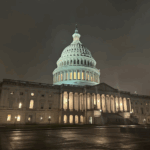
A backup defense authorization act unveiled this week would authorize $16.5 billion in Department of Energy nuclear-weapon spending for 2020, and explicitly authorize new program starts to bolster nuclear warhead and naval fuel efforts. Armed Services Committee Chair James Inhofe (R-Okla) lifted the lid on the so-called “skinny” National Defense Authorization Act (NDAA) late Monday. Chiefly, the measure would extend key military and DoE spending authorities — payments for military personnel and funds for some overseas war operations — beyond…

 By
By 











